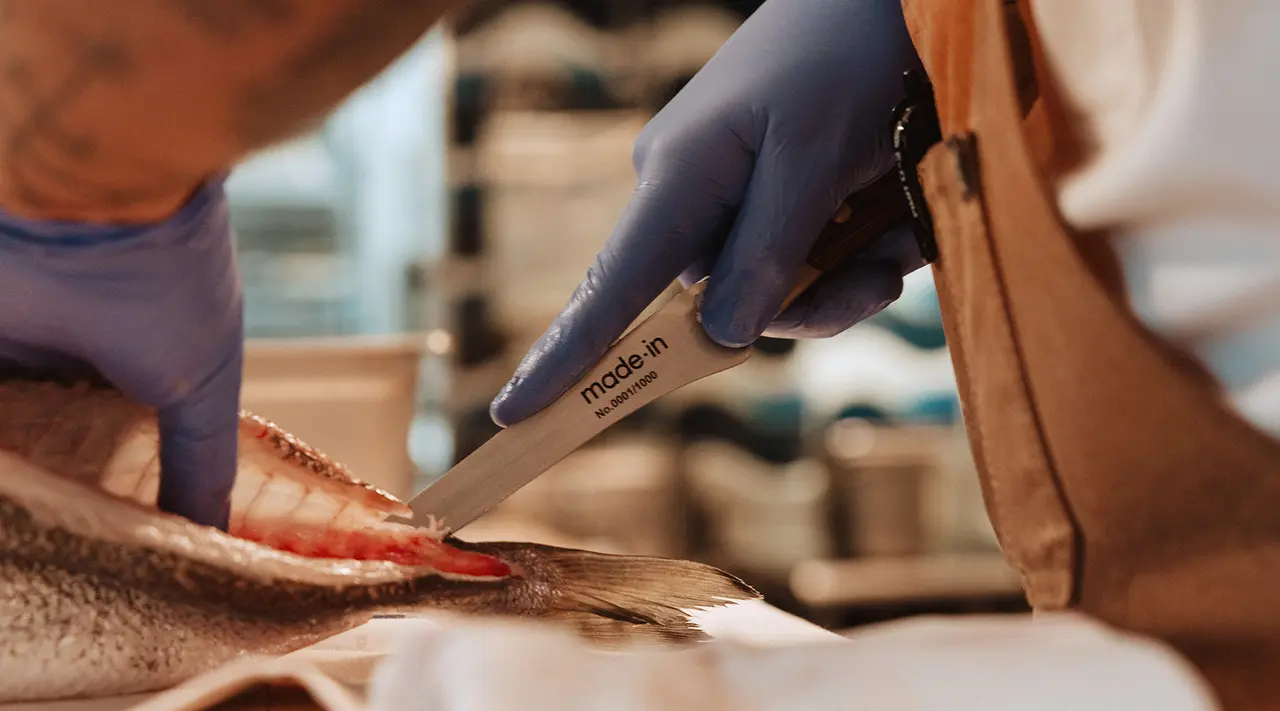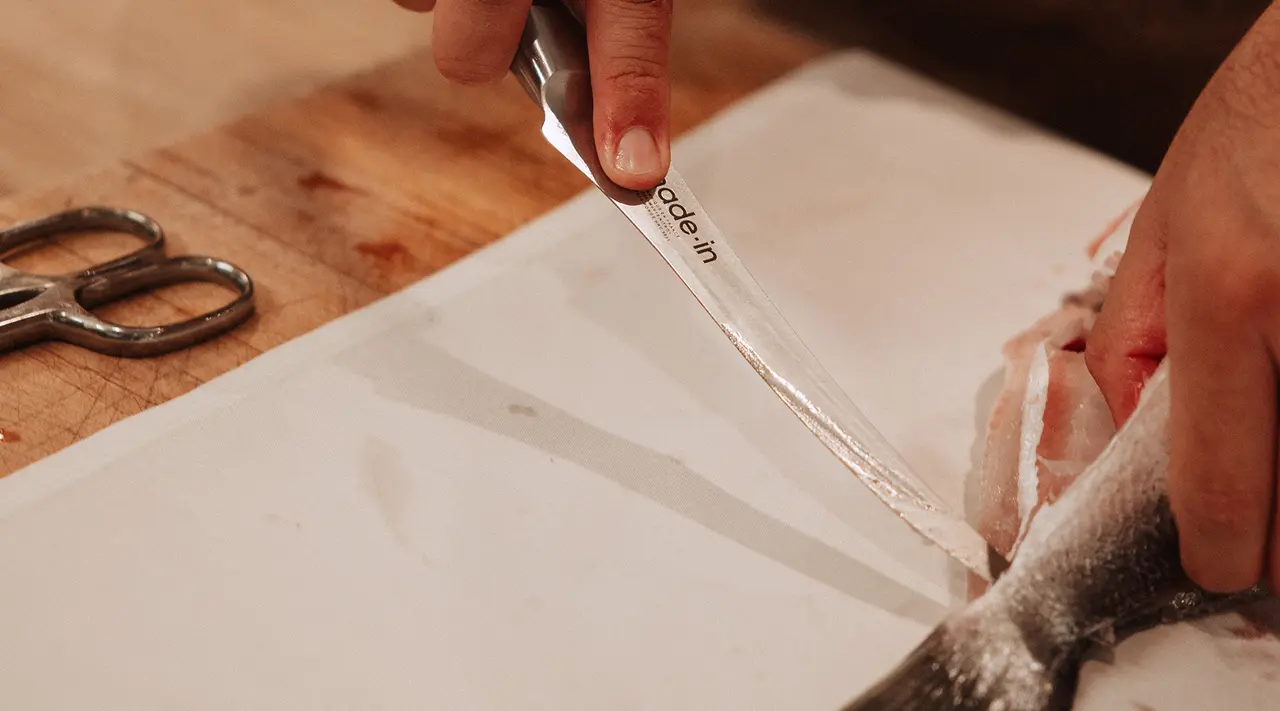If you’ve broken down a whole fish (or watched a professional do so at a fish market), then you’ve seen a fillet knife in action. A fillet knife features a flexible, long, skinny blade with a pointed tip. This shape and flexibility makes it easier to follow a fish’s natural contours, allowing you to make precise cuts that waste less flesh. A fillet knife also excels at skinning, removing fish scales, and slicing raw fish and other proteins.
Just like all your knives, it’s important to keep your fillet knife sharp. Keep reading to learn how to sharpen a fillet knife and maintain its razor sharp edge.
Why Keeping Your Fillet Knife Sharp is Essential

A sharp fillet knife is key, especially if you’re working with something delicate like fish. A dull knife is not only dangerous to work with in general, but it’ll tear up and damage the protein as you slice, rather than making clean cuts. With more precision, you’ll find it’s much easier to cut fish fillets and maneuver around bones.
Tools You’ll Need to Sharpen a Fillet Knife
Before you start sharpening, gather your tools.
Sharpening Stones
You’ve probably seen a professional knife sharpener working with a sharpening stone, and for good reason: they give optimum control when sharpening blades. Sharpening stones have a rough texture (known as grit) which assists in removing layers of steel from a knife blade. We’ll get more into that below.
Sharpening stones can be made from various natural and synthetic materials, but most chefs use stones made of synthetic materials like aluminum oxide or silicon carbide.
“Whetstone,” or sharpening stone, is the catchall term, but you might also see diamond stones and ceramic stones. A diamond stone is a stone covered with a thin layer of synthetic diamond particles. Ceramic stones, on the other hand, are made up of layers of synthetic ceramic particles. Each type comes with its own quirks and features.
Honing Rod
A honing rod, also called honing steel, is a long, steel rod that’s used to hone a knife’s blade. This is something you can do before you use a knife every time, since you’re realigning a blade’s angle (rather than removing steel when sharpening). With the fillet knife in particular, it’s a good idea to run the blade over a honing steel before every use, to keep the blade in alignment.
Electric Knife Sharpener
Electric sharpeners are quite popular, since they work quickly and don’t require much technical knowledge. However, if you’re not careful, they can wear your blade down too much, damaging the knife beyond repair. We recommend using a sharpening stone instead, which gives you more wiggle room and control over the finished product.
Sharpening Oil/Water
If you’re using a sharpening stone, you’ll likely need oil or water to soak the stone first. Both provide a little lubrication, which reduces friction when you’re sharpening and prevents the stone from heating and potentially damaging the blade. (You’re not out in the woods trying to start a fire with flint and steel.)
Since stone is porous, the oil or water will also carry away any blade particles and prevent the stone from clogging up. Depending on the stone you have, you’ll use either oil or water; the manufacturer’s instructions should tell you which to use.
How to Sharpen a Fillet Knife
Ready to sharpen your fillet knife? First, gather your materials. Since we prefer and recommend a sharpening stone rather than electric, that’s what we’ll dive into here. You’ll need a sharpening stone, oil or water (depending on the stone), a honing rod, and a towel.
As we wrote in our guide to using a sharpening stone, this is basically a two-step process: sharpening the blade by moving it gently across the stone at a slight angle, then finishing by smoothing it out and refining it.
Before you start, soak the stone per the stone’s instructions. Water stones are either sprinkled with water or submerged in water for 10 to 45 minutes. Oil stones get a layer of honing oil. Now you’re ready to get sharpening.
- First, set your stone on a towel or dishcloth to keep it from slipping. Position the stone so it’s perpendicular to your body. For general sharpening and maintenance, you should start with an 800 – 1,000 grit stone. This level is between a medium and fine grit and will remove some steel but not as much as a coarser stone.
- Next, find your angle. Also called the blade’s bevel, for the fillet knife, this is 12.5 degrees. (You can also use a penny to figure this out—check out our video on using whetstones to learn more.)
- Now pull the knife across the stone. Face the blade down at the bevel angle and, with even pressure, draw the blade towards you while going both down and across the length of the stone in a slightly rounded motion. (But really, check out the video to see this in action.) Especially if it’s your first time, pay attention to your hand placement. One hand should be gripping the handle, with the fingers of the other hand resting on the flat side of the blade. Stop when the blade’s tip touches the end of the stone closest to you.
- And now? Repeat! Repeat this motion 10 to 20 times, starting with the heel at the top of the stone, until a small fold of steel—called a burr—forms at the edge of the blade, and a thin layer of silty water begins to develop along the side. Flip the knife so that the opposite side is resting on the stone, and repeat the same process.
- Finally, refine. To smooth and polish the blade, use a stone with a finer grit, repeating the same sharpening movement. Some stones come with a coarse side and a fine side, or you may need two sharpening stones of differing grits. Aftering sharpening with the stone, it’s a good idea to use a honing steel to finish. This ensures the blade’s edge is locked in place.
Common Mistakes to Avoid
Take care to avoid these common pitfalls when sharpening and maintaining your fillet knife.
- Over-sharpening: An over-sharpened blade will lose its blade shape or have an uneven bevel, both of which can make the blade weak and dull. If you’re using a sharpening stone and sharpening minimally, though, you don’t have to worry too much about over-sharpening.
- Incorrect angle" Determining your blade’s angle and sharpening it to that angle is key. If you sharpen it to the incorrect angle, then you’ll end up blunting the blade’s edge, making for a dull knife. Check out our video to see how to determine and sharpen a blade to the correct angle.
- Neglecting regular maintenance. If you’re using your knife but not honing or sharpening it, then the blade will inevitably dull. Regular honing and periodic sharpening will keep the blade sharp.
How to Maintain Your Fillet Knife

Along with sharpening and honing, there are a few other things to keep in mind to keep your fillet knife in good shape.
Proper Cleaning and Storage
Always clean your knife after use. Wash the knife by hand with warm, soapy water and a non abrasive sponge or dishcloth, then dry it with a clean towel.
If you’re keeping your knife in a drawer, store it in a sheath to protect the blade from bumping around other objects (and your fingers when you go to reach for the knife), or opt for a drawer storage system. To keep it out of a drawer, opt for a knife block or wall-mounted magnetic strip.
Regular Maintenance Tips
In addition to routine honing, it’s important to use your knife on a cutting board. When choosing a cutting board, opt for relatively soft materials like wood and plastic (as compared to glass, granite, and steel). Since you’re using your fillet with raw fish and other proteins, we recommend reaching for a large plastic cutting board.
Plastic cutting boards can more easily be sanitized (especially in a dishwasher), reducing the risk of foodborne illness from uncooked fish.
Ready to Shop?
Whether you’re using your fillet knife to break down a fish you’ve caught yourself or one you’ve sourced from your local fishmonger, you’re all set to keep that blade in its best shape. Check out our new chef-approved Fillet Knife and add another quality knife to your collection.
































